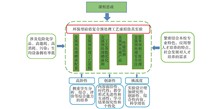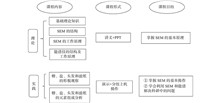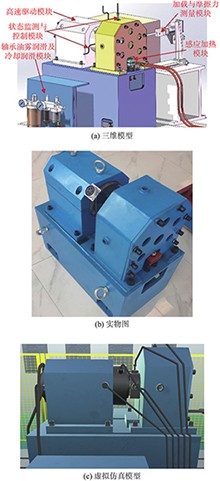In view of the current problems existing in the experimental courses of chemistry and chemical engineering, such as outdated content, single form, and less attractive to students, and in accordance with the goal of cultivating applied talents and the teaching requirements of comprehensive experiments in the major, the latest scientific research achievements are transformed and designed into “Virtual Simulation Experiment of Environmentally Friendly Silicon-Zirconium Composite Pretreatment Process” based on the “profoundness-innovation-challenging” standard, which is applied in assistant experimental teaching. The practical results show that the virtual simulation experimental teaching enhances the vigor and motive power to experimental teaching, promotes teaching efficiency, and increases the students’ experimental skills, innovation ability and comprehensive ability to solve complex problems.
To fully leverage the role of scanning electron microscopy (SEM) in the cultivation of innovative talents, a virtual simulation system has been introduced into the open experimental course of Micro World under Scanning Electron Microscopy, which solves the problems existing in the traditional open experimental teaching. The powerful functionality and interest of the virtual simulation system can effectively mobilize student’s initiative and enthusiasm for learning. By navigating through the increasingly challenging teaching-learning process of “independent learning?mastering knowledge?designing practical content?completing experimental inquiry”, students will actively construct relevant knowledge systems, stimulate innovation awareness, and improve scientific research innovation abilities. In this way, a multi-level experimental teaching mode of “irtualization first, reality second, supplementing reality with virtualization, and combination of virtualization and reality” is thus formed, which broadens and deepens the scope of open experimental teaching, showing excellent teaching practice results.
Aiming at the difficulty in understanding the control principle and adjustment process of the double closed-loop ratio control, a hardware-in-the-loop simulation platform has been developed. The platform is composed of process flow analysis, double closed-loop ratio control scheme configuration, flow chart configuration, proportional-integral-derivative (PID) parameter tuning, and simulation operation modules. On this platform, the process analysis, sensor and actuator selection, control scheme design and automatic control loop operation of the double closed-loop ratio control system can be conducted. The results show that the platform developed comprehensively covers the theoretical knowledge of double closed loop control and has good interactivity, and the experimental process is clear and highly operable. The platform illustrates the deep integration of theoretical knowledge and practical problems, which is conducive to cultivating students’ problem-solving ability.
The material test of friction and wear under the high-speed and high-temperature conditions has some difficulties, such as long experimental period, high experimental complexity and security risks. In order to lower the risks, periods, and costs during operating, the testing device and corresponding virtual simulation system are developed. The testing device can be used to conduct the material experiments of tribology characteristics for bearings, gears, seals in aero-engines. The combination of virtuality simulations and reality operations is helpful for students to promote the understanding of the knowledge of basic theory, operating steps, experimental processes, results presentations of high-speed and high-temperature friction and wear testing, and students can receive practical training without the restrictions of time and space. After completing the virtual simulation experiment, offline physical operation training is carried out. In this way, students can form a realistic understanding of the structural composition and operation process of the high-speed and high-temperature friction and wear testing device. Finally, the study performance of different learners are evaluated based on virtuality simulations, reality operations, and experiment reports by the ways of process assessment and outcome assessment.
In order to solve the problems in teaching of professional background courses, such as difficulty in grasping the integration of theoretical teaching and equipment cases, difficulty in establishing the correlation between theory and practice in existing experimental plans, and singularity in evaluating the effectiveness of experimental teaching, a virtual experimental system for automatic control principles with missile control as a case background is constructed. The design concept of this virtual experimental system is based on the course of “Automatic Control Principles”, which applies the principle of constructivism and follows the idea of “intuitive introduction, layer by layer progressive, high-order synthesis”. It realizes the process of cultivating practical engineering skills through virtual experiments. By applying this experimental system to teaching practice, students are able to fully understand and proficiently apply the application technology of control theory in equipment installation through the study of equipment examples, which better cultivates their ability to transform theory into practice. The construction and application of this system have good reference value for the construction of virtual experiments in this type of professional background courses.
In view of the abstract design content of the control principle controller, the lack of students’ intuitive understanding of the actual control case, and the difficulty of traditional experimental teaching resources to meet the teaching needs due to the constraints of site, time, economic cost and other conditions, a design scheme of the first-order inverted pendulum virtual experiment system based on semi-physical simulation is proposed, and the key technologies of the virtual experiment system are introduced in detail, including the establishment of the physical model of the first-order inverted pendulum, the implementation of customized software and hardware, communication methods between virtual inverted pendulums and embedded targets, etc. Through the virtual experiment system, open automatic control and embedded system experimental teaching can be carried out, so as to achieve the purpose of entertaining, eliminating the boredom of learning control principles, and stimulating students’ enthusiasm for learning.
Based on the achievement of the second prize of the National Science and Technology Progress Award for the new technology of rapid thermal cycling and high gloss injection molding and aimed at cultivating high-level innovative talents in the new era, a virtual simulation experimental project system for the entire process of process and equipment cognition, rapid heat cycle injection molding macro and micro integration simulation, and production simulation is designed, which mainly focuses on 42 inch LCD TV front shell steam heating rapid heat cycle injection molding production. The virtual simulation experimental course of “Rapid Heat Cycle Injection Molding Process Macro and Micro Integration Simulation and Production Simulation” is constructed, and the teaching practice is carried out, which achieves effective teaching outcomes.
Using the three-dimensional modeling and rendering technology, a virtual simulation experiment system for fluid flow around marine engineering environments is built and used for the practical teaching, which aims to enhance students’ ability to connect theory with practice and stimulate their innovative thinking through experimental teaching. The experimental system includes modules for cognitive learning, online test, fluid flow demonstration experiment, cylinder flow experiment, and bridge pier flow experiment. Based on the particle image velocity measurement (PIV) technology, a prototype experiment of flow around a circular cylinder is finished in the precision experimental hydraulic flume, and a prototype experiment of flow around a circular pier of Jiashao Bridge is finished based on the large-scale particle image velocity measurement (LSPIV) technology. Then the project embeds the experimental operation process and measured data into the experimental system, so that students can master the theory of flow around and practical operation skills in the simulation. These experiments constitute progressively organized teaching contents. The teaching method follows a stepwise four stages, namely, teaching, practice, assessment, and application, and incorporates multidimensional assessment methods to motivate students’ enthusiasm for experimentation, cultivate a rigorous and practical experimental attitude, facilitate the effective transfer of theoretical knowledge to practical application, and achieve the teaching goal of fostering practical innovation capabilities as the central task.
In response to the booming trend of composite materials and the goal of “two properties and one degree” in higher education simulation experimental teaching, from the perspective of how to show the comprehensive mechanical properties of new composite materials to students within limited experimental time, a virtual simulation model based on Hypermesh/Dyna platform is constructed with Nomex honeycomb composites as a case to simulate the thin-wall properties of multilayer property composites with phenolic resin-aramid matrix. The mechanical properties of composite materials for the characteristics of compression is comprehensively discussed, including bending, impact, shear, tensile, high-speed shooting and other experiments. The research results are instructive for the application of virtual simulation technology in teaching complex experiments.
Practical teaching has a strong supporting effect on the professional personnel training system for the major of building electricity and intelligence. In the offline teaching process, it is often limited by many factors such as venue, number of equipment, class hours, and safety. At the same time, part of teaching content under actual combat background can’t be carried out. To overcome the above shortcomings, a professional practice teaching platform is developed based on the virtual simulation technology and the platform is applied to the course teaching. Practice has shown that the mixed virtual simulation teaching effect of online and offline based on this teaching platform is good, and it is of great significance to improve the quality of talent cultivation in this specialty.












